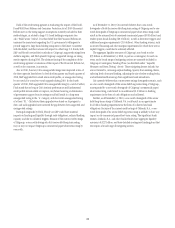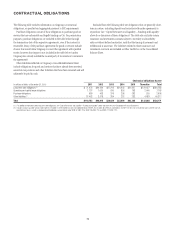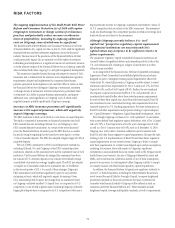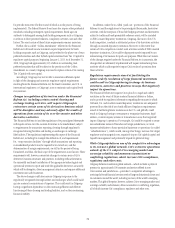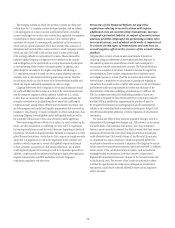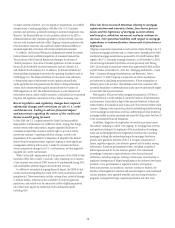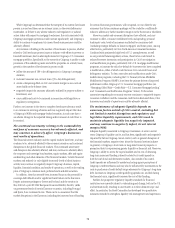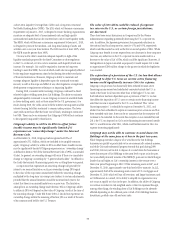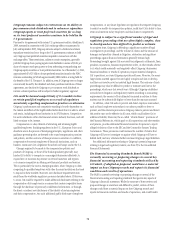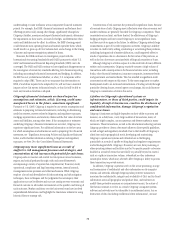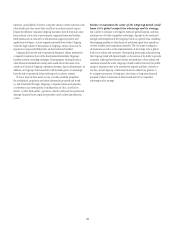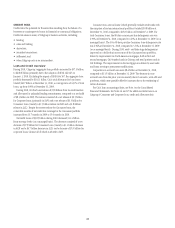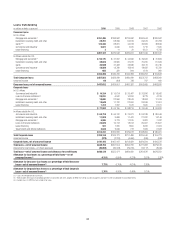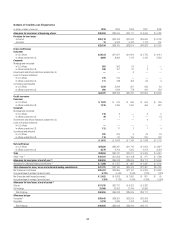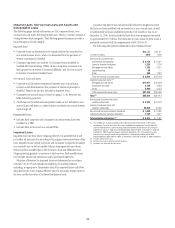Citibank 2010 Annual Report Download - page 81
Download and view the complete annual report
Please find page 81 of the 2010 Citibank annual report below. You can navigate through the pages in the report by either clicking on the pages listed below, or by using the keyword search tool below to find specific information within the annual report.79
understanding or cause confusion across comparative financial statement
periods. For example, the FASB’s financial instruments and balance sheet
offsetting projects could, among other things, significantly change how
Citigroup classifies, measures and reports financial instruments, determines
the impairment on those assets, accounts for hedges, and determines when
assets and liabilities may be offset. In addition, the FASB’s leasing project
could eliminate most operating leases and instead capitalize them, which
would result in a gross-up of Citi’s balance sheet and a change in the timing
of income and expense recognition patterns for leases.
Moreover, the FASB continues its convergence project with the
International Accounting Standards Board (IASB) pursuant to which U.S.
GAAP and International Financial Reporting Standards (IFRS) are to be
converged. The FASB and IASB continue to have significant disagreements on
the convergence of certain key standards affecting Citi’s financial reporting,
including accounting for financial instruments and hedging. In addition,
the SEC has not yet determined whether, or when, U.S. companies will be
required to adopt IFRS. There can be no assurance that the transition to
IFRS, if and when required to be adopted by Citi, will not have a material
impact on how Citi reports its financial results, or that Citi will be able to
meet any transition timeline so adopted.
Citigroup’s financial statements are based in part on
assumptions and estimates, which, if wrong, could cause
unexpected losses in the future, sometimes significant.
Pursuant to U.S. GAAP, Citigroup is required to use certain assumptions and
estimates in preparing its financial statements, including in determining
credit loss reserves, reserves related to litigation and regulatory exposures,
mortgage representation and warranty claims and the fair value of certain
assets and liabilities, among other items. If the assumptions or estimates
underlying Citigroup’s financial statements are incorrect, Citigroup may
experience significant losses. For additional information on the key areas
for which assumptions and estimates are used in preparing Citi’s financial
statements, see “Significant Accounting Policies and Significant Estimates”
below, and for further information relating to litigation and regulatory
exposures, see Note 29 to the Consolidated Financial Statements.
Citigroup may incur significant losses as a result of
ineffective risk management processes and strategies, and
concentration of risk increases the potential for such losses.
Citigroup seeks to monitor and control its risk exposure across businesses,
regions and critical products through a risk and control framework
encompassing a variety of separate but complementary financial, credit,
operational, compliance and legal reporting systems, internal controls,
management review processes and other mechanisms. While Citigroup
employs a broad and diversified set of risk monitoring and risk mitigation
techniques, those techniques and the judgments that accompany their
application may not be effective and may not anticipate every economic and
financial outcome in all market environments or the specifics and timing of
such outcomes. Market conditions over the last several years have involved
unprecedented dislocations and highlight the limitations inherent in using
historical data to manage risk.
Concentration of risk increases the potential for significant losses. Because
of concentration of risk, Citigroup may suffer losses even when economic and
market conditions are generally favorable for Citigroup’s competitors. These
concentrations can limit, and have limited, the effectiveness of Citigroup’s
hedging strategies and have caused Citigroup to incur significant losses,
and they may do so again in the future. In addition, Citigroup extends large
commitments as part of its credit origination activities. Citigroup’s inability
to reduce its credit risk by selling, syndicating or securitizing these positions,
including during periods of market dislocation, could negatively affect its
results of operations due to a decrease in the fair value of the positions, as
well as the loss of revenues associated with selling such securities or loans.
Although Citigroup’s activities expose it to the credit risk of many different
entities and counterparties, Citigroup routinely executes a high volume of
transactions with counterparties in the financial services sector, including
banks, other financial institutions, insurance companies, investment banks
and government and central banks. This has resulted in significant credit
concentration with respect to this sector. To the extent regulatory or market
developments lead to an increased centralization of trading activity through
particular clearing houses, central agents or exchanges, this could increase
Citigroup’s concentration of risk in this sector.
A failure in Citigroup’s operational systems or
infrastructure, or those of third parties, could impair its
liquidity, disrupt its businesses, result in the disclosure of
confidential information, damage Citigroup’s reputation
and cause losses.
Citigroup’s businesses are highly dependent on their ability to process and
monitor, on a daily basis, a very large number of transactions, many of
which are highly complex, across numerous and diverse markets in many
currencies. These transactions, as well as the information technology services
Citigroup provides to clients, often must adhere to client-specific guidelines,
as well as legal and regulatory standards. Due to the breadth of Citigroup’s
client base and its geographical reach, developing and maintaining
Citigroup’s operational systems and infrastructure is challenging,
particularly as a result of rapidly evolving legal and regulatory requirements
and technological shifts. Citigroup’s financial, account, data processing or
other operating systems and facilities may fail to operate properly or become
disabled as a result of events that are wholly or partially beyond its control,
such as a spike in transaction volume, cyberattack or other unforeseen
catastrophic events, which may adversely affect Citigroup’s ability to process
these transactions or provide services.
In addition, Citigroup’s operations rely on the secure processing, storage
and transmission of confidential and other information on its computer
systems and networks. Although Citigroup takes protective measures to
maintain the confidentiality, integrity and availability of Citi’s and its clients’
information across all geographic and product lines, and endeavors to
modify these protective measures as circumstances warrant, the nature of
the threats continues to evolve. As a result, Citigroup’s computer systems,
software and networks may be vulnerable to unauthorized access, loss or
destruction of data (including confidential client information), account


